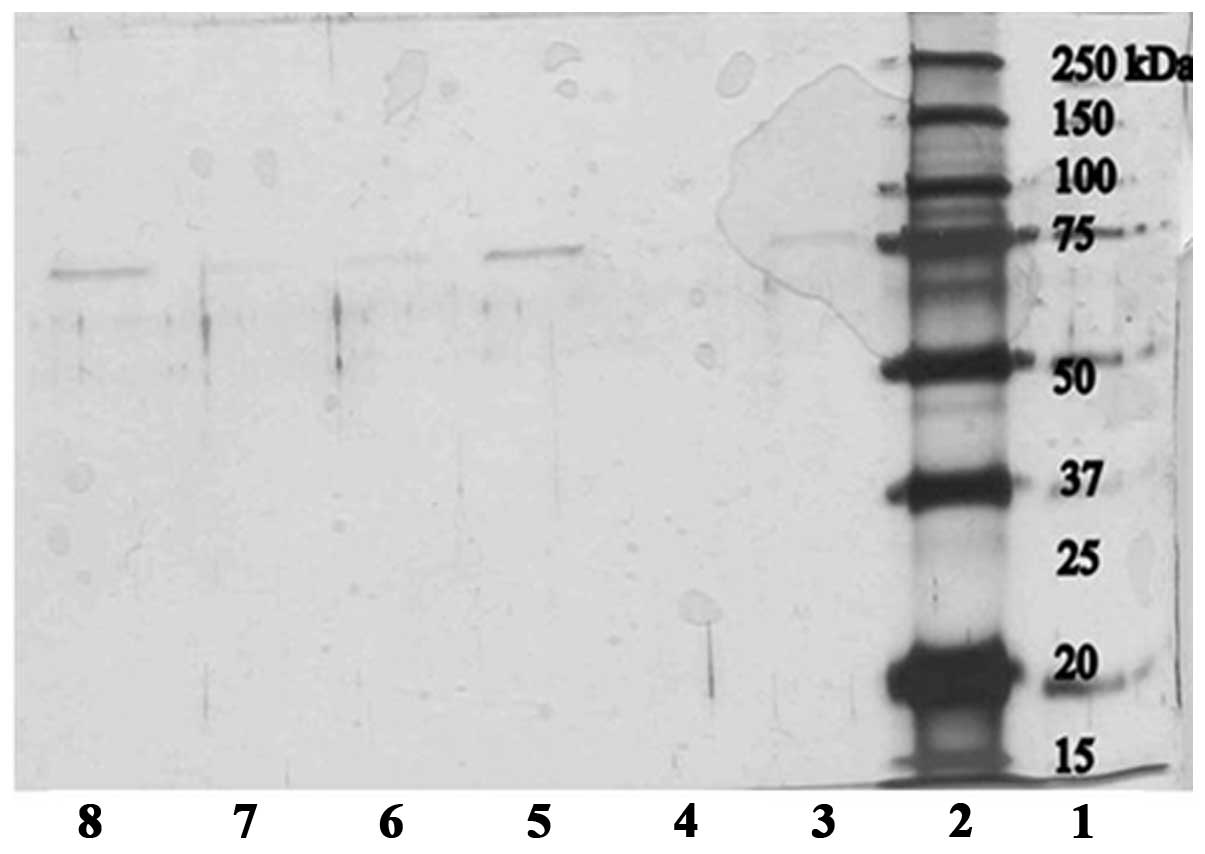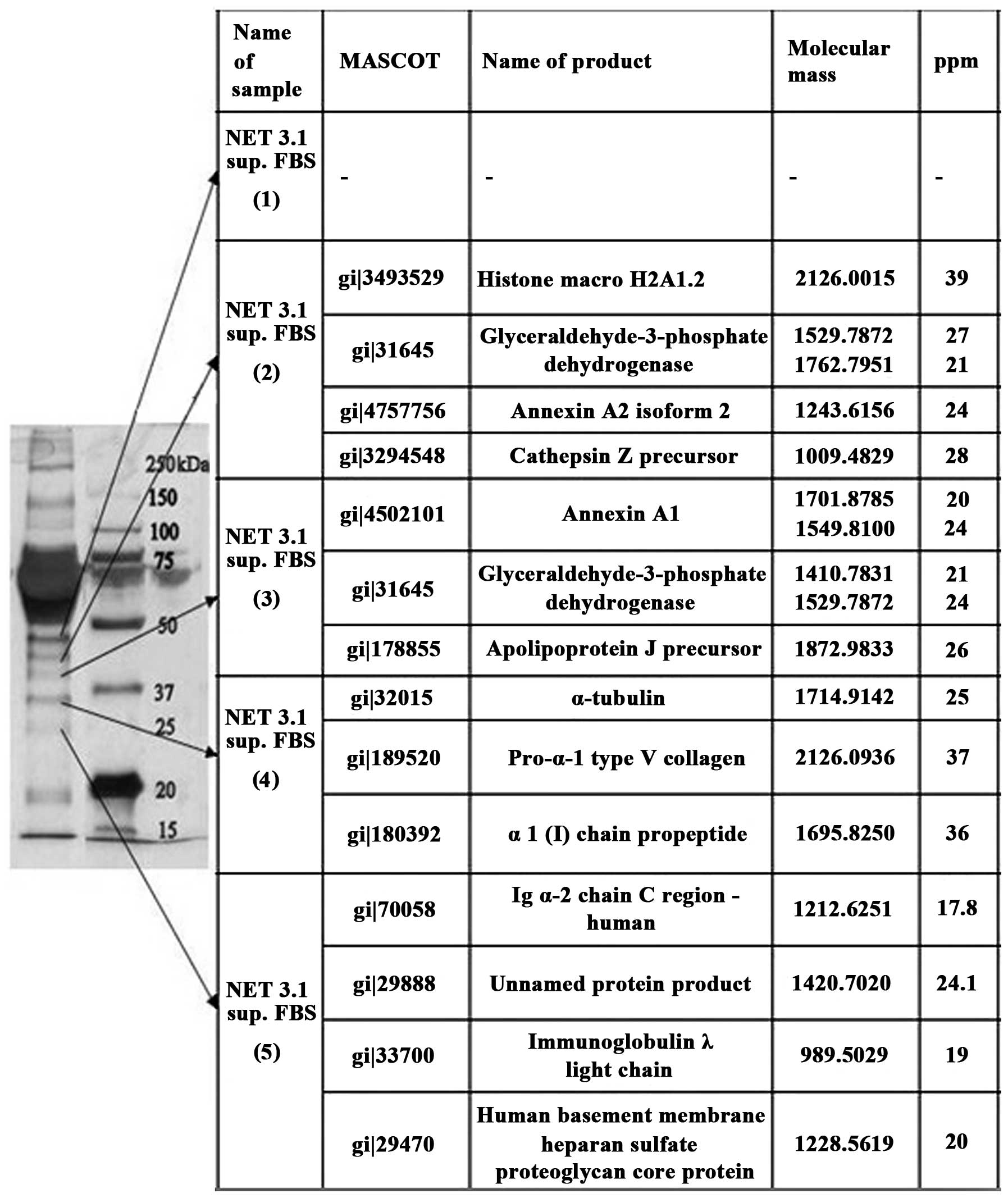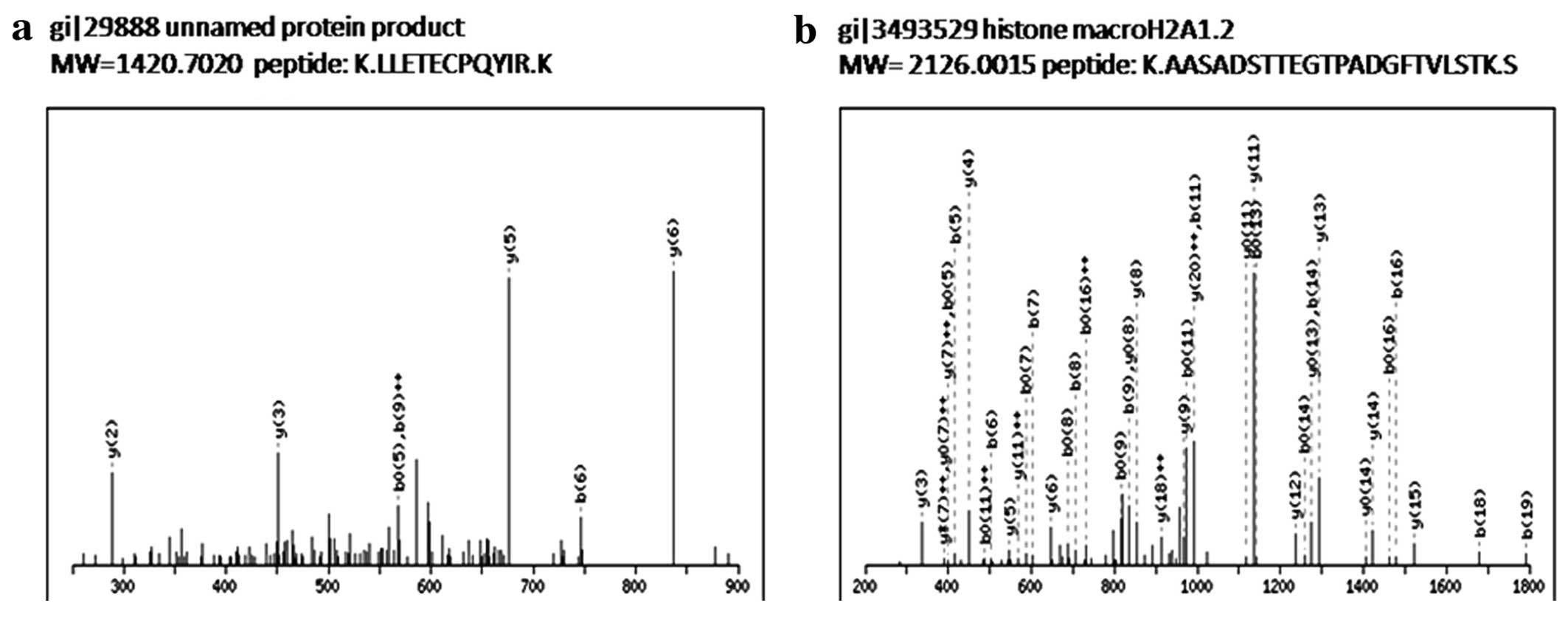|
1
|
Wulfkuhle JD, Liotta LA and Petricoin EF:
Proteomic applications for the early detection of cancer. Nat Rev
Cancer. 3:267–275. 2003. View
Article : Google Scholar : PubMed/NCBI
|
|
2
|
Srinivas PR, Verma M, Zhao Y and
Srivastava S: Proteomics for cancer biomarker discovery. Clin Chem.
48:1160–1169. 2002.PubMed/NCBI
|
|
3
|
Klöppel G: Tumour biology and
histopathology of neuroendocrine tumours. Best Pract Res Clin
Endocrinol Metab. 21:15–31. 2007. View Article : Google Scholar : PubMed/NCBI
|
|
4
|
Jensen RT: Current diagnosis and
management of gastrointestinal neuroendocrine tumours. Dig Liver
Dis. 33:212–214. 2001. View Article : Google Scholar : PubMed/NCBI
|
|
5
|
Szczeblowska D: Diagnostics and treatment
of neuroendocrine tumors of the digestive tract in the light of the
present standards. Pol Merkur Lekarski. 22:437–441. 2007.(In
Polish). PubMed/NCBI
|
|
6
|
Tyers M and Mann M: From genomics to
proteomics. Nature. 422:193–197. 2003. View Article : Google Scholar : PubMed/NCBI
|
|
7
|
Anderson NL, Matheson AD and Steiner S:
Proteomics: applications in basic and applied biology. Curr Opin
Biotechnol. 11:408–412. 2003. View Article : Google Scholar
|
|
8
|
Khalil AA: Biomarker discovery: a
proteomic approach for brain cancer profiling. Cancer Sci.
98:201–213. 2007. View Article : Google Scholar : PubMed/NCBI
|
|
9
|
Bergquist J, Baykut G, Bergquist M, Witt
M, Mayer FJ and Baykut D: Human myocardial protein pattern reveals
cardiac diseases. Int J Proteomics. 2012:3426592012. View Article : Google Scholar : PubMed/NCBI
|
|
10
|
O’Neil SE, Lundbäck B and Lötvall J:
Proteomics in asthma and COPD phenotypes and endotypes for
biomarker discovery and improved understanding of disease entities.
J Proteomics. 75:192–201. 2011. View Article : Google Scholar
|
|
11
|
de Noo ME, Tollenaar RA, Deelder AM and
Bouwman LH: Current status and prospects of clinical proteomics
studies on detection of colorectal cancer: hopes and fears. World J
Gastroenterol. 12:6594–6601. 2006.PubMed/NCBI
|
|
12
|
Issaq HJ, Conrads TP, Janini GM and
Veenstra TD: Methods for fractionation, separation and profiling of
proteins and peptides. Electrophoresis. 23:3048–3061. 2002.
View Article : Google Scholar : PubMed/NCBI
|
|
13
|
Matt P, Fu Z, Fu Q and Van Eyk JE:
Biomarker discovery: proteome fractionation and separation in
biological samples. Physiol Genomics. 33:12–17. 2008. View Article : Google Scholar
|
|
14
|
Tiselius A: A new apparatus for
electrophoretic analysis of colloidal mixtures. Trans Faraday Soc.
33:524–531. 1937. View Article : Google Scholar
|
|
15
|
Wang H and Hanash S: Multi-dimensional
liquid phase based separations in proteomics. J Chromatogr B Analyt
Technol Biomed Life Sci. 787:11–18. 2003. View Article : Google Scholar : PubMed/NCBI
|
|
16
|
Ralhan R, Desouza LV, Matta A, Chandra
Tripathi S, Ghanny S, Datta Gupta S, et al: Discovery and
verification of head-and-neck cancer biomarkers by differential
protein expression analysis using iTRAQ labeling, multidimensional
liquid chromatography, and tandem mass spectrometry. Mol Cell
Proteomics. 7:1162–1173. 2008. View Article : Google Scholar : PubMed/NCBI
|
|
17
|
Lawrie LC, Fothergill JE and Murray GI:
Spot the differences: proteomics in cancer research. Lancet Oncol.
2:270–277. 2001. View Article : Google Scholar
|
|
18
|
Petricoin EF, Ardekani AM, Hitt BA, Levine
PJ, Fusaro VA, Steinberg SM, et al: Use of proteomic patterns in
serum to identify ovarian cancer. Lancet. 359:572–577. 2002.
View Article : Google Scholar : PubMed/NCBI
|
|
19
|
Schiess R, Wollscheid B and Aebersold R:
Targeted proteomic strategy for clinical biomarker discovery. Mol
Oncol. 3:33–44. 2009. View Article : Google Scholar : PubMed/NCBI
|
|
20
|
Anderson NL, Polanski M, Pieper R, Gatlin
T, Tirumalai RS, Conrads TP, et al: The human plasma proteome: a
nonredundant list developed by combination of four separate
sources. Mol Cell Proteomics. 3:311–326. 2004. View Article : Google Scholar : PubMed/NCBI
|
|
21
|
Omenn GS, States DJ, Adamski M, Blackwell
TW, Menon R, Hermjakob H, et al: Overview of the HUPO Plasma
Proteome Project: results from the pilot phase with 35
collaborating laboratories and multiple analytical groups,
generating a core dataset of 3020 proteins and a publicly-available
database. Proteomics. 5:3226–3245. 2005. View Article : Google Scholar : PubMed/NCBI
|
|
22
|
Carpentier SC, Witters E, Laukens K,
Deckers P, Swennen R and Panis B: Preparation of protein extracts
from recalcitrant plant tissues: an evaluation of different methods
for two-dimensional gel electrophoresis analysis. Proteomics.
5:2497–2507. 2005. View Article : Google Scholar : PubMed/NCBI
|
|
23
|
Millioni R, Puricelli L, Iori E and
Tessari P: Rapid, simple and effective technical procedure for the
regeneration of IgG and HSA affinity columns for proteomic
analysis. Amino Acids. 34:507–509. 2008. View Article : Google Scholar
|
|
24
|
Weber K and Osborn M: The reliability of
molecular weight determinations by dodecyl sulfate-polyacrylamide
gel electrophoresis. J Biol Chem. 244:4406–4412. 1969.PubMed/NCBI
|
|
25
|
Li X, Kuang J, Shen Y, Majer MM, Nelson
CC, Parsawar K, et al: The atypical histone macroH2A1.2 interacts
with HER-2 protein in cancer cells. J Biol Chem. 287:23171–23183.
2012. View Article : Google Scholar : PubMed/NCBI
|
|
26
|
Nobels FR1, Kwekkeboom DJ, Coopmans W,
Schoenmakers CH, Lindemans J, De Herder WW, et al: Chromogranin A
as serum marker for neuroendocrine neoplasia: comparison with
neuron-specific enolase and the alpha-subunit of glycoprotein
hormones. J Clin Endocrinol Metab. 82:2622–2628. 1997.PubMed/NCBI
|
|
27
|
Sardana G, Marshall J and Diamandis EP:
Discovery of candidate tumor markers for prostate cancer via
proteomic analysis of cell culture-conditioned medium. Clin Chem.
53:429–437. 2007. View Article : Google Scholar : PubMed/NCBI
|















